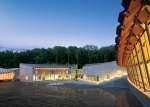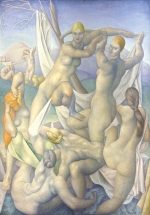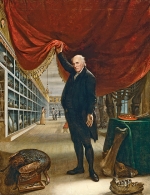|
Sunday, 01 January 2012 02:20
Although a number of American still life artists who gained prominence during the nineteenth century were still active and influential after 1900, the still life genre in America in the early part of the twentieth century was profoundly impacted by modernist developments. Generally European in origin, American painters experienced these influences either through travel abroad or through exposure to those who had directly encountered the modernist current in France or Germany. No one modern movement influenced still life painting the most; instead, various painters brought stylistic changes to the genre based on their prevailing interests.1
Sunday, 01 January 2012 02:02
H. G. Wells, writing this passage in 1933, knew that he was living in a time of absolute and unprecedented transformation. People's daily lives were changing, and this filled the great author and futurist with both excitement and foreboding. He saw that, given the extraordinary new powers science had delivered, humanity might perfect the world or use these new capabilities to bring about total annihilation.
Wells was living in the nervous and frenetic time that fell between the grim bookends of two World Wars. Technologically, this was not an especially innovative period. The electric light bulb, the automobile, the airplane, the skyscraper, the radio, and the telephone all predate World War I. It was a time of development and dispersal rather than invention; it was during the period between the two World Wars that these life-changing technologies became widespread.
Sunday, 01 January 2012 02:00
In his brief yet wide-ranging career, Theodore Robinson established himself as a major figure in the early years of American impressionism, one of the only artists to work alongside Claude Monet. New York dealer Ira Spanierman, who along with the Baltimore Museum of Art's Sona Johnston is co-authoring the catalogue raisonne of Robinson's work, calls Robinson "one of the few greats" in American impressionism, an assessment backed up by the impressive prices for the artist's work, with a record auction price in excess of two million dollars.
Sunday, 01 January 2012 01:39
In late November of 1907, New York newspapers trumpeted a controversy that had the art world in an uproar. Headlines exclaimed: "Artist Chase Leaves: Withdraws from the New York School of Art, Which He Founded"; and "Wm. M. Chase Forced Out of New York Art School: Triumph for the 'New Movement' Led by Robert Henri." William Merritt Chase (1849-1916) and Robert Henri (1865-1929) were renowned teachers and two of the best known American artists at the turn of the twentieth century. But their relationship, which had begun in mutual admiration, ended in headlining animosity, as the two fought bitterly over the nature of art and its future direction in America. Enacting their differences on a national stage, they forced a generation of artists to address the same issues and to shape their own conclusions.
Thursday, 20 October 2011 03:51
The variety of decoration found on silver spoons made in America from the eighteenth to the twentieth century is staggering. Beginning with hand worked designs in the 1700s, increased mechanization, innovation and consumer demand in the 1800s led to hundreds of elaborate patterns.
Silver spoons from the late 1700s to the early 1800s were handmade, with the bowls “sunk” by hammering into a conforming mold. The back of the bowl offered the maker a surface for decoration, giving consumers the chance to select additional stamped motifs such as a bird or shell. The amount of handle decoration often was modest, with choices for the consumer generally limited to engraved monograms or crests near the tip, and the overall handle shape. The three typical handle shapes from this period are the downturned oval handle, the hexagonal handle, and the fiddle handle (Fig. 1).
Wednesday, 19 October 2011 02:46
Art history has long been dominated by male artists. A number of factors prevented women from achieving artistic prominence,1 primary among them was the fact that until the nineteenth century women were denied entrance to schools and academies, and even then they were not permitted to work from nude models. And while opportunities for women began to expand in the late nineteenth century, social pressures continued to discourage women from pursuing a career in the arts. Encouraged to dabble in drawing and painting as part of a well-rounded education, women were expected to become full-time wives and mothers—an expectation that continued well into the twentieth century.
Wednesday, 19 October 2011 02:43
Museum of Early Southern Decorative Art’s founder, Frank Horton, purchased this silver cann marked by Charleston, South Carolina, silversmith Lucas Stoutenburgh (1691–1743) in the 1960s. It is boldly engraved with a coat of arms featuring a rampant lion placed between eight cross-crosslets and crested with a combed cockatrice rising from a ducal coronet. Whose arms were these? Horton wrote to the College of Arms in London, England, in an attempt to identify the family the crest represented. They responded that the coat of arms was identifiable, but that the cost for the research would be greater than the £20 he enclosed.1
Wednesday, 19 October 2011 02:39
For over two hundred years the Brandywine Valley region has attracted artists, including James Brade Sword, Jasper Cropsey, William T. Richards, Herman Herzog, George Cope, Edward Moran, and many others. The still extant Turner’s Mill in Chadds Ford was the location for the summer school of famed illustrator and teacher Howard Pyle. N. C. Wyeth was inspired by Pyle to settle in Chadds Ford, where he raised his remarkably talented family, and where his artist son Andrew and grandson Jamie Wyeth have also lived.
For forty years the Brandywine River Museum has fulfilled its mission to collect, preserve, exhibit, and interpret artistic and historical objects related to the Brandywine region, including the art of the Wyeth family, American illustration, landscape, and still life painting.
Wednesday, 19 October 2011 02:36
Henry Melchior Muhlenberg (1711–1787) was the patriarch of the Lutheran Church in America and progenitor of one of the most influential Pennsylvania German families in history (Fig. 1). This year marks the 300th anniversary of his birth. Three of Henry’s sons also achieved significant renown: Peter (1746–1807) as a general during the American Revolution, Frederick (1750–1801) as the first Speaker of the U.S. House, and Henry Jr. (1753–1815) as a botanist. President Franklin Delano Roosevelt, speaking during the 1942 bicentennial of Henry Muhlenberg’s arrival in this country, said, “Clergymen, soldiers, scholars, and statesmen, the Muhlenbergs have represented the best in our national life since the earliest days of the Republic.”1
Wednesday, 19 October 2011 02:32

During his lifetime, landscape painter William Keith (1838–1911) had a reputation that spread widely across the country from his home base in San Francisco. Especially towards the end of his career in the early twentieth century, his works were sought after by major collectors in the East, as well as by Californians.
At the Panama Pacific International Exposition of 1915, four years after his death, Keith’s work was given a separate gallery—he was the only artist to receive such an honor. But as modernism drove nineteenth-century art into oblivion, not even Keith was spared. Keith was luckier than many other California artists of his time; he acquired a tireless advocate and biographer in the Swiss-born Christian Brother, Herman Emanuel Braeg, whose name in the church was Brother Cornelius. A professor of German literature and sacred studies at Saint Mary’s College, Moraga, half an hour east of San Francisco, Cornelius saw his first Keith paintings in naturalist John Muir’s house in 1908, which led to his obsessive quest for the facts of Keith’s life and for Keith paintings in private collections and public institutions throughout Northern California. In this crusade, he was helped by Keith’s widow, Mary McHenry Keith, and niece, Elizabeth Keith Pond, who assembled a multi-volume compendium of material—letters, newspaper reviews, catalogues of his exhibitions, etc., relating to Keith. The “Keith Miscellanea,” eventually found a home at the Bancroft Library, University of California, Berkeley, while Cornelius’s biography, Keith, Old Master of California, was published in 1942.
Wednesday, 19 October 2011 02:01
Hand-made objects, long subservient to an artificial hierarchy of the arts established in the Renaissance, underwent a paradigm shift in the postwar period, defined here as 1945 to 1969, and became an assertive form of artistic expression. Craftspeople found affirmation in the creations of Alexander Calder and Isamu Noguchi, who roamed freely across media and disciplines without regard for superficial divisions. The changed status of craft was not widely accepted by the fine arts world, but the altered relationship was nevertheless made plain by those who appropriated craft-based materials and techniques into aspects of postwar art, and by craftspeople whose work addressed such fine-arts concerns as process, form, and content (Fig. 1).
Wednesday, 19 October 2011 01:57

The opening of any major new American museum is news, especially when the museum has been designed by world-renowned architect, Moshe Safdie. But the opening of that museum in the heart of the Arkansas Ozarks sends reverberations through the art world.
Located in the heart of the nation, far from the urban art meccas of New York and Los Angeles, Crystal Bridges was founded by Alice Walton, daughter of Sam Walton of Walmart fame. The museum (Fig. 1) is situated at the bottom of a steep wooded ravine on a 120-acre park that was part of the Walton family’s original estate. Alice, who grew up roaming these woods, wanted a museum that worked in harmony with the surrounding forest, integrating the experience of art and nature for its visitors. A natural stream fed by Crystal Spring, which gives the museum its name, flows through the site and is spanned by two copper-roofed bridges housing galleries and the museum restaurant. The stream is dammed by weirs, producing two large ponds around which seven additional buildings are nestled.
Wednesday, 19 October 2011 01:51

Few moments in American cultural history are as recognizable as the 1920s—their mere mention conjures flappers, Fords, and skyscraper cities. And yet, American artists responded to their dizzying modern world with art that evoked stillness, clarity, and order. With Youth and Beauty: Art of the American Twenties, the Brooklyn Museum celebrates the work of sixty-seven painters, sculptors, and photographers who responded to the cultural upheaval in an era framed by the aftermath of the Great War and the onset of the Great Depression. Confronted with an environment newly altered by a sweeping wave of mechanization and urbanization, they coined a lean modern realism in an effort to process a barrage of stimuli, and to create something authentic and inscribed with the adaptive struggles of the individual. In the new twenties realism, liberated modern bodies resonate with classical ideals, the teeming modern city is rendered empty and silent, and still life is pared to an essentialized clarity.
Saturday, 15 October 2011 04:43
Diego Velázquez de Cuéllar (1465–1524) of Spain led the first expedition to colonize Cuba in 1511, founding Cuba’s first seven towns: Baracoa (1512), Bayamo (1513), Santiago de Cuba (1514), Sancti Spiritus (1514), Trinidad (1514), Santa Maria del Puerto del Principe (1515), and Havana (1515). With Havana’s natural harbor as a strategic springboard for trade, Cuba was the most important outpost of the Spanish empire by the last quarter of the sixteenth century.
Toward the end of the century, Cuba’s supply of gold was all but exhausted and the island’s oligarchy began to concentrate on agricultural potential. In addition to the exportation of tropical hardwoods, tobacco plantations began to prosper, bringing wealth to the island, particularly to Havana, which became the center of the production and dispatch of tobacco for the entire Spanish empire.
Saturday, 15 October 2011 04:38
Although most fraktur were made in southeastern Pennsylvania, where a
large number of German-speaking immigrants had settled, the tradition
was carried into central and western Pennsylvania as well as the
Shenandoah Valley, the Midwest, and even Ontario by later generations of
German-speaking people. Although rare, fraktur can even be associated
with Delaware, such as this colorful certificate made for Samuel
Mecknolte (McNolde), who was born in New Castle County, Delaware, in
1770 (Fig. 2). It is one of the only known fraktur made for a person
born in Delaware, though it was probably created in Montgomery County,
Pennsylvania, where Samuel was a tavern keeper.
Saturday, 15 October 2011 04:35
When the Bucks County landscape painters first came to national
prominence in the late nineteenth and early twentieth centuries,
landscape painting was one of the cutting edge, avant-garde styles of
the day. Painters like Redfield, Garber, and Spencer built stellar
careers, and many Bucks County artists exhibited and won prizes at the
most prestigious art venues in the country.
Saturday, 01 October 2011 06:00

The schooner yacht America has been the subject of more paintings than any other pleasure or commercial vessel, perhaps rivaled only by the frigate Constitution. In 1851, the year of her victorious race off Cowes, England, she was portrayed by many of the most noted American and British marine artists of the day, and remains a favorite subject in paintings by many of today’s marine artists.
Conceived at the instigation of an English businessman, built in one of New York’s foremost shipyards, and sailed by a syndicate of New York yachtsmen, the America was intended to demonstrate the United States’ shipbuilding skill at Prince Albert’s Great Exhibition at London in 1851. America was designed by George Steers, who was then employed at the shipyard of William H. Brown and assigned by Brown to supervise the schooner’s construction. Brown had agreed to build the vessel under a contract that made him its owner unless or until the syndicate decided it had a winner and agreed to purchase it. After different trial races, America was purchased by the syndicate and sailed to England to race for, and win, a trophy which we know today as the America’s Cup.
Saturday, 01 October 2011 03:59
Concord, Massachusetts, has a lot of history for a small town. Founded in 1635 as the first inland settlement of Massachusetts Bay Colony, Concord had a population of about fifteen hundred through the eighteenth and early nineteenth centuries. Nevertheless, Concord on several occasions—most notably at the beginning of the Revolutionary War—rose to play a role on the national stage. The events of April 19, 1775, which saw the first military engagement with British forces, permanently affected the community’s view of itself (Fig. 1). Revolutionary hero Lafayette’s visit in 1825 stirred up a rivalry with neighboring Lexington over just where the Revolution began, one that was still bitter enough in 1875 that President Grant was constrained to eat lunch in both towns during the celebration of the centennial of the battle. When the Civil War began, many in town conceived of it as another Revolution.
Saturday, 01 October 2011 03:54
As both the official residence and the working office of the president of the United States, the White House and its furnishings have invited great interest and comment since President John Adams became the first resident in November 1800. This fall and winter, a selection of decorative arts treasures from the White House collection are on view in the exhibition Something of Splendor: Decorative Arts from the White House, hosted by the Renwick Gallery of the Smithsonian American Art Museum. Organized in honor of the fiftieth anniversary of the White House Historical Association, the exhibition includes many objects never before seen outside of the White House. The furniture, ceramics, glass, metals, and textiles included in the show, all used by first families and their guests, document the changing fashions of the White House while also providing a glimpse into both the public and private lives of its famous occupants.
Saturday, 01 October 2011 03:25

How do you build upon one of the great collections of American art? And how can such familiar art appear transformed and enlivened? That was the challenge undertaken this summer by the Pennsylvania Academy of the Fine Arts (PAFA), where its curatorial team, which includes a trio of experts in eighteenth, nineteenth, twentieth, and twenty-first century art, collaborated to rethink the themes and layouts of the galleries through 1950. The result is dynamic new juxtapositions, thematic groupings, recent acquisitions, and resuscitated gems that will challenge and delight visitors. Collection strengths such as history painting, early American landscape, trompe l’oeil still-life, American impressionism, art by Robert Henri and The Eight, and Philadelphia modernism have been given special attention. Important works of Surrealism and early Abstract Expressionism pulled from PAFA’s holdings will likely surprise viewers familiar with our nineteenth-century holdings. After the initial rotation opens this September, periodic changes will place works such as Winslow Homer’s Fox Hunt and other treasures in new contexts, and curator of contemporary art, Julien Robson, will make use of the historical collection to reveal the links between past and present. Some highlights of the reinstallation are on the following pages.
|
|
|
|
|